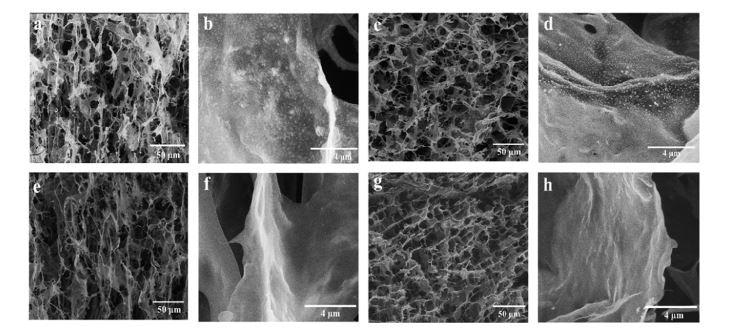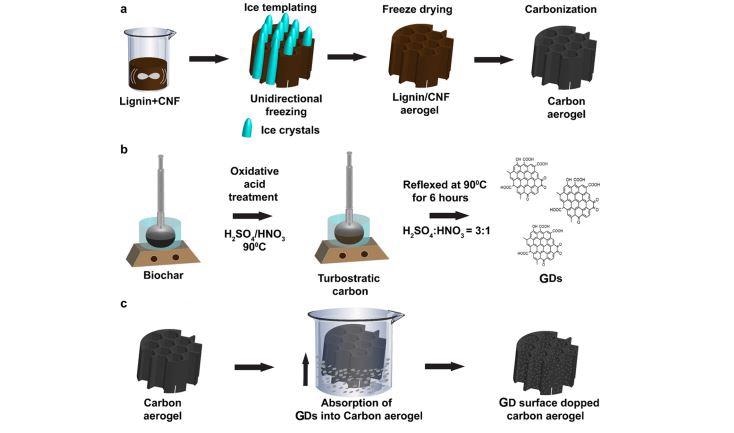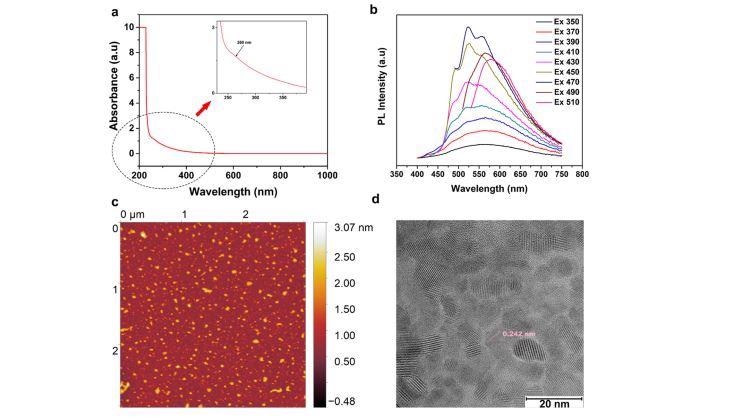Researchers at Luleå University of Technology in Sweden have demonstrated in the journal Applied Electronic Materials the high-performance electrochemical properties of biomass-derived graphene dots as a functional additive for green carbon aerogels. As such, these aerogels could provide real opportunities for practical use and application when designing sustainable energy solutions.

Microstructure of the prepared materials. (a) and (e) Longitudinal views of KLCA60 and GD-doped KLCA60; magnified images of the longitudinal sections showing the surface texture of both are shown in (b) and (f). Cross-sectional views of KLCA60 and GD-doped KLCA60 are shown in (c) and (g), and the respective high magnification images are shown in (d) and (h). Image Credit: Bony, T. et al., Applied Electronic Materials.
While research and development of aerogels, in general, has been ongoing for some time, the focus on carbon aerogels has been stirred by market activity, technological advances, and the demand for green energy solutions.
The overlap of environmental challenges associated with anthropogenic climate change and critical energy issues has led to the search for innovations in energy materials and devices. Typically, energy storage solutions and power/energy density are the leading factors driving these new initiatives.
Supercapacitors
Carbon aerogels are a common component part of supercapacitors, making up the carbon material used for the electrode in the electrostatic double-layer capacitors (EDLCs).
Supercapacitors are energy storage devices that generally store between 10 -100 times more energy per unit volume or mass than electrolytic capacitors, and can tolerate an increased frequency of charge and discharge cycles.
This makes them more efficient and well-suited for applications that necessitate a large number of rapid charge and discharge cycles with fluctuating loads, such as in consumer electronics, medical devices, and electric vehicles.
However, the performance of the EDLCs in the supercapacitor is dependent on the double-layer to support the physical adsorption of ions. Therefore, to unlock the true potential of ELDCs, the development of a good active carbon-based material (electrode) with an excellent specific capacity is necessary.
Carbon aerogels have emerged as the ideal material for application in ELDCs, as they demonstrate the qualities required for a good superconductor electrode material: high porosity, low density, interconnected structure, and the capacity to achieve a hierarchal pore structure.
Graphene
In their quest to find a material with the greatest potential for use in supercapacitors, the researchers in the journal Applied Electronic Materials discovered that graphene-based materials show the most promise for supercapacitor applications as a result of their “high surface area and superior electrical conductivity.”

Schematic representation of the preparation steps for GD-doped carbon aerogel. (a) Preparation of carbon aerogel from lignin/CNF suspension. (b) Synthesis of GDs from biochar using oxidative acid treatment involving 3:1 concentration of H2SO4/HNO3; the reaction mixture was refluxed for 6 h at 90 °C. (c) Surface doping of prepared carbon aerogels using GDs synthesized from biochar. Image Credit: Bony, T. et al., Applied Electronic Materials.
In recent decades, much has been written and discovered about graphene after first being isolated by physicists Andre Geim and Konstantin Novoselov at the University of Manchester. Amongst its many favorable properties, it is believed that graphene could be one of the most sustainable materials, as statistically speaking carbon is the fourth most abundant element in the entire universe.
However, graphene is limited in some capacity when being used in supercapacitors, as the charge transfer only achieves full potential when the material forms a “dense cross-linked network.” This in turn reduces the surface area of the material and limits the energy-storage density below the expected theoretical value.
Biobased GDQs
As a result, the latest development in graphene-based nanomaterials is graphene quantum dots (GDQs) characterized by an atomically thin hybridized plane of less than 100nm. GDQs demonstrate excellent properties, including excellent optical qualities, good dispersibility, and an abundance of active sites.

(a) UV−visible spectrum. (b) Photoluminescence (PL) spectra at different excitation wavelengths, showing the optical properties of the produced GDs in an aqueous medium (0.01 wt %). (c) Atomic force microscopic image of GDs. (d) TEM image showing graphene particles with an ordered carbon structure and a size range of 5−15 nm. Image Credit: Bony, T. et al., Applied Electronic Materials.
These qualities, along with the nanosize of the material, make GDQs an ideal material for application in aerogels for ELDCs, for improving the performance and storage capability of supercapacitors.
Additionally, the research team at Luleå has presented a method for the green synthesis of carbon aerogels and GDQs deriving from commercially available biochar. The team have identified biomass food waste such as rice husks, waste peels, and other biomass derivatives as possible contenders for GQD production due to their renewable, economical, and sustainable characteristics.
Green Energy Solutions
Proving the concept of utilizing waste-derived biocarbon to develop advanced, functional carbon nanomaterials is a bold step for the team at Luleå, as it can also improve the electrochemical properties of green carbon aerogels.
Therefore, this group of researchers has shown how graphene dotted biobased carbon aerogels offer great potential for the next generation of energy storage applications requiring green and renewable resources.
With the growing demand for green energy solutions, this study comes at a critical time. Sources of renewable energy are considered key to the fight against the climate crisis. Additionally, supercapacitors offer high-power, storage-solutions that can help improve alternative energy solutions.
References:
Bony, T, Gejo, G, Anton, L, Concina, I, Geng, S, Vomiero, A, Sain, M, and Oksman, K. (2021). ‘Electrochemical Properties of Biobased Carbon Aerogels Decorated with Graphene Dots Synthesized from Biochar’, ACS Applied Electronic Materials Article. https://pubs.acs.org/doi/abs/10.1021/acsaelm.1c00487
Disclaimer: The views expressed here are those of the author expressed in their private capacity and do not necessarily represent the views of AZoM.com Limited T/A AZoNetwork the owner and operator of this website. This disclaimer forms part of the Terms and conditions of use of this website.